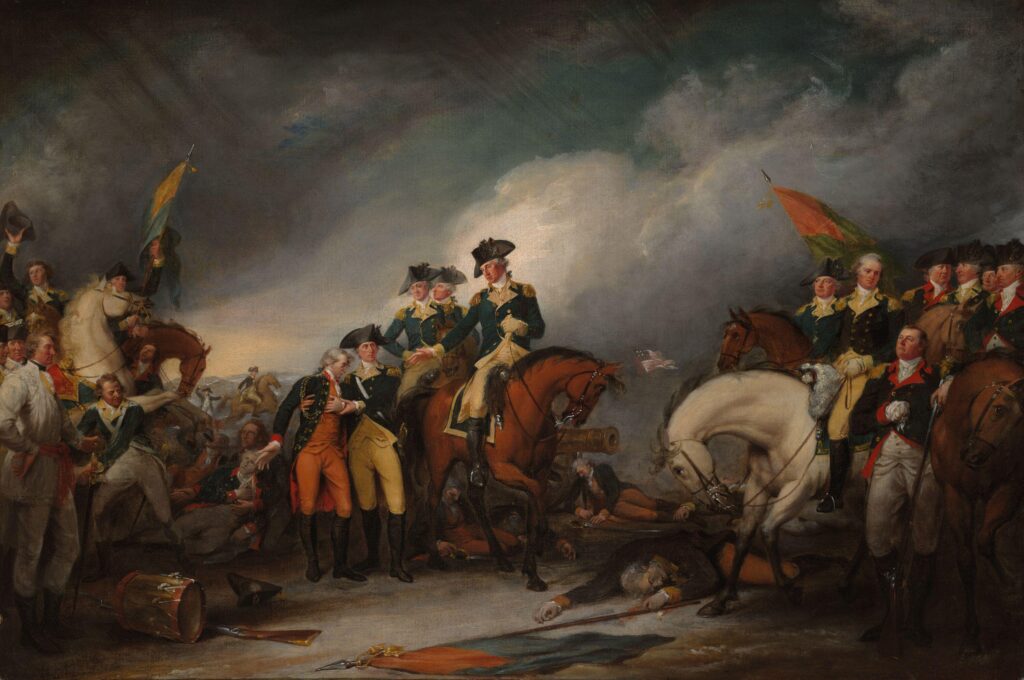
The resilience displayed by the Continental Army was paramount in England’s failure to defeat the American rebellion, especially as that insurrection was supported by weapons and ammunition from France and then subsequently by the armed forces of its monarch, Louis XVI. According to 18th-century military protocol, the side that held the field at the conclusion of battle was regarded as victorious; and, from that perspective, the redcoats won most of the engagements. They achieved unambiguous success (in chronological order) at Long Island, Kip’s Bay, Fort Washington, Brandywine Creek, Paoli, Germantown, Savannah, Charleston, Camden, and Waxhaws, while suffering clear-cut defeats at Princeton, Saratoga, Stony Point, Cowpens, and Yorktown. But they also “won” in a narrow tactical sense at Breed’s Hill, White Plains, Freeman’s Farm, Guilford Courthouse, Hobkirk Kill, and Eutaw Springs, by forcing the Americans to retire from the battlefield. However, those technical victories represented a strategic setback for the crown’s forces in that they depleted their precious reserves of military manpower, failed to neutralize enemy armies in the field, and were unable to sway public opinion against the insurrection.
When General Nathanael Greene, chosen by Washington to lead the Continental Army in the Southern Theater in 1780, memorably asserted his resolve to rebound from one of those purely tactical reversals, he arguably articulated the overall strategy behind the American war effort. Writing to the Chevalier de La Luzerne, Louis XVI’s minister to the United States, three days after the battle of Hobkirk Hill—near Camden, South Carolina—in April 1781, Greene declared, “We fight, get beat, rise, and fight again.”
In the end, the insurgent side won the contest by not losing it. Their lengthy war of attrition against a militarily superior opponent eventually sapped Britain’s will to fight following Lord Cornwallis’s surrender to the Franco-American army at Yorktown, Virginia in October 1781. There followed parliament’s vote to abandon the struggle and any claim to sovereignty over the 13 former colonies. All England had to show for its eight-year-long effort to subdue the rebellion were losses of 40,000 casualties and 50,000,000 pounds. These included at least 20,000 soldiers and sailors whose lives ended in America, the West Indies, or at sea, some from battlefield wounds but more from disease—often in some squalid setting—and typically without the benefit of a stone to mark the final resting place of anyone other than a commissioned officer.
All this begs the question of whether Britain could have ever “won” in terms of indefinitely suppressing the American quest for independence or whether that independence was inevitable. John Adams insisted “the Revolution was in the minds and hearts of the people” (the Whig faction, anyway) and “was effected before the war commenced.” If so, would a purely military victory by the crown have made that population any more amenable to subjugation? Could the mother country have possibly borne the cost of deploying a permanent army of occupation in America large enough to effectively impose British rule over a largely hostile people spread across an expanse of territory that dwarfed Great Britain in size? For how long? What reason is there to assume that these provinces would not at some point have attained their sovereignty given the experience of Australia, Canada, India, Ireland, and New Zealand? George III’s ministers would have done well to heed the great parliamentary orator Edmund Burke in March 1775, when he argued for conciliating the American colonies: “Magnanimity in politics is not seldom the truest wisdom, and a great empire and little minds go ill together.”
Written by David Price, Washington Crossing Historic Park Historical Interpreter. Much of this article is adapted from David’s forthcoming work, Winning the Ten Crucial Days: The Keys to Victory in George Washington’s Legendary Winter Campaign (Brookline Books). He has authored three other books that relate to the “Ten Crucial Days”: John Haslet’s World, The Road to Assunpink Creek, and Rescuing the Revolution. His other volume, The Battle of Harlem Heights, 1776, is part of the Westholme Small Battles series and was accepted into the permanent collection of the Connecticut Museum of Culture and History. David has been awarded the National Society of the Sons of the American Revolution Bronze Good Citizenship Medal and Certificate of Appreciation in recognition of his work as an author, speaker, and historical interpreter at WCHP and Princeton Battlefield State Park. More information about him and his work can be found at dpauthor.com.

